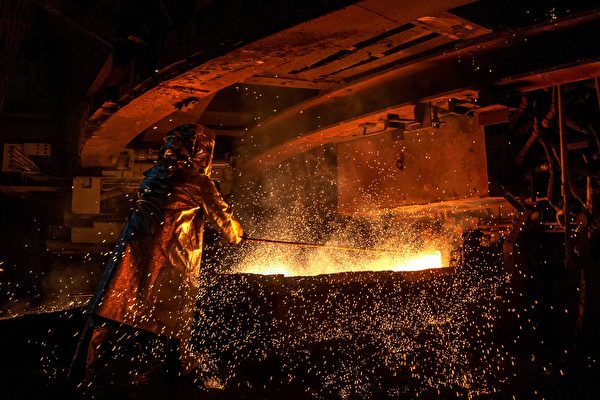German scientists have developed a highly efficient nickel metal extraction method to significantly reduce pollution and energy consumption in response to the growing demand for lithium batteries and other nickel-based products in the contemporary technology sector. This breakthrough comes as the production of nickel, cobalt, and lithium metals necessary for lithium batteries requires a large amount of energy and can easily lead to environmental pollution.
Nickel metal is widely used not only in lithium batteries but also in stainless steel and other alloys applied in daily life products, shipbuilding, infrastructure, and transportation systems. It possesses properties such as ferromagnetism, slow oxidation, and corrosion resistance, making it essential for permanent magnets, alloys, and some high-temperature alloys.
A report estimates that by 2040, global demand for nickel is projected to reach 6 million tons due to the increasing electrification of infrastructure and transportation systems. However, extracting nickel from low-quality nickel ore (which accounts for 60% of the current nickel reserves) requires multiple energy-intensive stages, resulting in concerns over energy consumption and carbon dioxide emissions.
Traditional nickel ore extraction processes involve stages like calcination, smelting, and refining, all of which consume significant energy. To maximize production efficiency, factories often opt for high-quality nickel ore due to the low nickel content and high impurities like magnesium silicate, sulfur, iron, aluminum, clay, present in low-quality nickel ore, leading to increased energy, chemical reagents, and cost requirements during the extraction process.
In a groundbreaking development, researchers at the Max Planck Institute for Sustainable Materials Research in Germany have introduced an energy-efficient, low-carbon, and high-performance method that bypasses traditional nickel ore extraction processes. This new method allows for the rapid extraction of nickel-iron alloy from overlooked low-quality nickel ore (high-impurity laterite nickel ore).
Published in the journal “Nature” on April 30, the research garnered over 18,000 views and reports from more than ten technology news outlets. The team utilized the “Hydrogen Plasma Smelting Reduction” (HPSR) method as an alternative to conventional carbon-based reduction processes, breaking down the crystal structure of low-quality nickel ore in the reaction furnace into simpler iron, nickel-magnesium, oxygen, and silicate oxide ions without the need for catalytic agents, only requiring the addition of argon gas (Ar) and minimal hydrogen gas (H2) for reduction.
The “Hydrogen Plasma Smelting Reduction” method employs hydrogen gas ionized through an arc or high-frequency electric field, where hydrogen ions at several thousand degrees Celsius reduce metal oxides in the ore into liquid metal for easy separation and collection, commonly used for extracting metals like iron and nickel from ores, with water vapor as a byproduct.
Subsequently, in the reaction furnace, smelting, reduction, and refining processes occur simultaneously, forming a “single metallurgical step.” This method reduces the reduction process to 2 to 4 minutes, converting high-impurity laterite nickel ore into low-impurity, high-purity nickel-iron alloy (with nickel content up to 44wt%, iron content 55wt%, silicon content less than 0.04wt%, phosphorus content around 0.01wt%, and calcium content less than 0.09wt%).
Moreover, this method not only reduces carbon dioxide emissions by 84% but also increases energy efficiency by 18%, utilizing renewable electricity and hydrogen for operation. It broadens the range of usable nickel ores, making low-quality nickel ore extraction more cost-effective and sustainable, further supporting the advancement of electrification in the transportation industry.
Researchers note that the purified nickel alloys obtained through this innovative method can be directly used in stainless steel and magnet alloy production without the energy-intensive refining process. Further refining these high-purity nickel alloys enables their direct use in lithium battery electrode materials. Additionally, the furnace slag generated during the reduction process can be repurposed into common building materials like bricks and cement.
The new extraction method is also applicable to cobalt metal, currently widely used in electric vehicles and energy storage systems. The research team plans to optimize the production process and scale for practical industrial applications to enhance the wider utilization of low-quality nickel ore.
The lead author of the study, Dr. Ubaid Manzoor from the Institute for Sustainable Materials Research, remarked, “Continuing to produce nickel in the traditional manner for electrification merely shifts the problem rather than solving it.”
Professor Isnaldi Souza Filho, head of the “Sustainable Materials Synthesis” group at the Institute for Sustainable Materials Research and the corresponding author of the study, highlighted, “Through controlling the thermodynamic processes inside the electric arc furnace using hydrogen plasma, we enabled the breakdown of complex mineral structures in low-quality nickel ore into simpler metal ions without the need for catalytic agents.”
Dr. Manzoor explained that this method allows for the reduction of nickel ore into simpler ions at the reaction interface while ensuring continuous reactions of unreduced portions. These reactions can be achieved through high-current short arcs, integration of external electromagnetic stirring devices below the furnace, or gas injection methods.
The research was supported by the European Research Council (ERC) through advanced funding.

